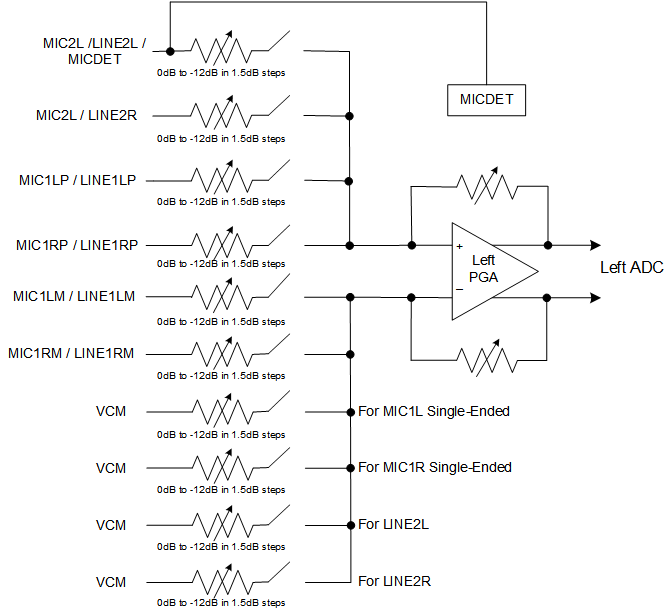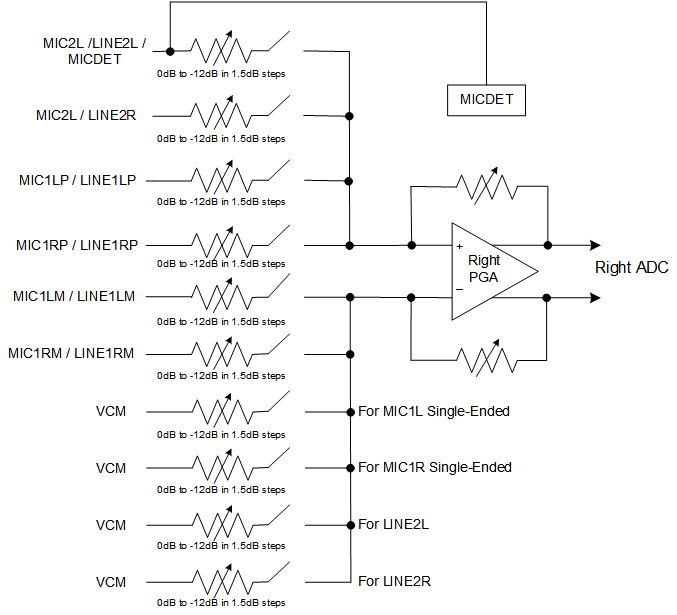SLAS510G March 2007 – February 2021 TLV320AIC3104
PRODUCTION DATA
- 1 Features
- 2 Applications
- 3 Description
- 4 Revision History
- 5 Description (Continued)
- 6 Device Comparison Table
- 7 Pin Configuration and Functions
- 8 Specifications
- 9 Parameter Measurement Information
-
10Detailed Description
- 10.1 Overview
- 10.2 Functional Block Diagrams
- 10.3
Feature Description
- 10.3.1 Hardware Reset
- 10.3.2 Digital Audio Data Serial Interface
- 10.3.3 Audio Data Converters
- 10.3.4 Stereo Audio DAC
- 10.3.5 Audio Analog Inputs
- 10.3.6 Analog Fully Differential Line Output Drivers
- 10.3.7 Analog High-Power Output Drivers
- 10.3.8 Input Impedance and VCM Control
- 10.3.9 MICBIAS Generation
- 10.3.10 Short-Circuit Output Protection
- 10.3.11 Jack and Headset Detection
- 10.4 Device Functional Modes
- 10.5 Programming
- 10.6 Register Maps
- 11Application and Implementation
- 12Power Supply Recommendations
- 13Layout
- 14Device and Documentation Support
Package Options
Refer to the PDF data sheet for device specific package drawings
Mechanical Data (Package|Pins)
- RHB|32
Thermal pad, mechanical data (Package|Pins)
- RHB|32
Orderable Information
10.3.5 Audio Analog Inputs
The TLV320AIC3104 includes six single-ended audio inputs. These pins connect through series resistors and switches to the virtual ground terminals of two fully differential operational amplifiers (one per ADC and PGA channel). By selecting to turn on only one set of switches per operational amplifier at a time, the inputs can be multiplexed effectively to each ADC and PGA channel. Figure 10-12 and Figure 10-13 show the signal paths for the left cannel and right channel, respectively.
 Figure 10-12 Left Channel Signal Path
Figure 10-12 Left Channel Signal Path Figure 10-13 Right Channel Signal Path
Figure 10-13 Right Channel Signal PathBy selecting to turn on multiple sets of switches per operational amplifier at a time, mixing can also be achieved. Mixing of multiple inputs can easily lead to PGA outputs that exceed the range of the internal operational amplifiers, resulting in saturation and clipping of the mixed output signal. Whenever mixing is being implemented, the user should take adequate precautions to avoid such saturation from occurring. In general, the mixed signal should not exceed 2 Vp-p (single-ended).
In most mixing applications, there is also a general need to adjust the levels of the individual signals being mixed. For example, if a soft signal and a large signal are to be mixed and played together, the soft signal generally should be amplified to a level comparable to the large signal before mixing. In order to accommodate this need, the TLV320AIC3104 includes input level control on each of the individual inputs before they are mixed or multiplexed into the ADC PGAs, with gain programmable from 0 dB to –12 dB in 1.5-dB steps. Note that this input level control is not intended to be a volume control, but instead used occasionally for level setting. Soft-stepping of the input level control settings is implemented in this device, with the speed and functionality following the settings used by the ADC PGA for soft-stepping.
Figure 10-14 shows the single-ended mixing configuration for the left-channel ADC PGA, which enables mixing of the signals LINE1L, LINE2L, LINE1R. The right-channel ADC PGA mix is similar, enabling mixing of the signals LINE1R, LINE2R, LINE1L.
 Figure 10-14 Left-Channel, Single-Ended Analog Input Mixing Configuration
Figure 10-14 Left-Channel, Single-Ended Analog Input Mixing Configuration